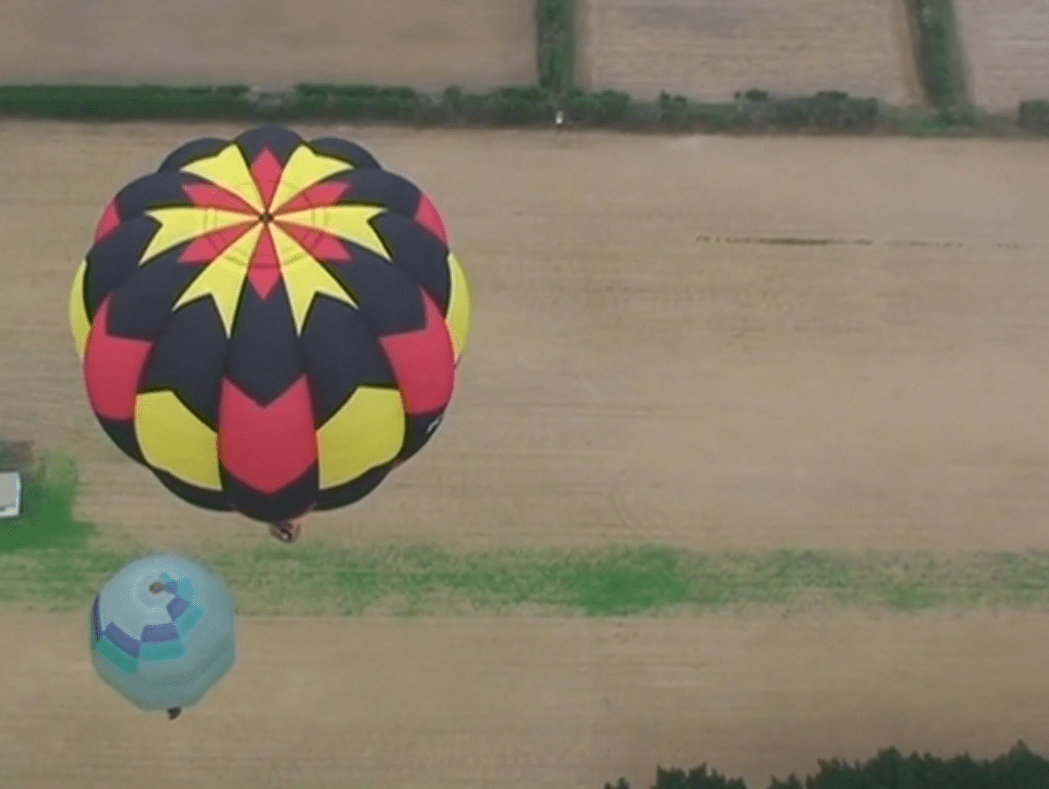Hot air rises. And with it sound. At least that’s what Breath of Wind made me imagine. A sound cloud high in the air: co-mingling rising pockets of song, traffic noise, flatulence and aural seepages of every kind. A surreal soundscape of terrestrial time just past: bubbling up and around, wafting and waning together, billowing and fluttering up and away, on a still day.
I went gliding once. What I learnt was that what commercial airplane pilots call turbulence, glider pilots call lift. You are held by and rise on cushions of air. You watch for birds to see the rising thermals that you may follow, spiraling up. I felt fragile and very small, but I also felt strong and free.
Big rich kids the world over will have got camera drones for Christmas. They’re out there in the field now, trying to keep their robo-copter insects steady just above the ground, GPS at the ready, wrestling with the controls to avoid a crash. It’s all about control. About being attached to the coordinates, the lines mapped over terra firma.
Breath of Wind (2009) Phil Dadson
Anchors away: Phil Dadson works with a very different kind of experience. We go higher, gently rising, falling, rising. The sky becomes our common field, full of streaming plumes of sound. Looking down, over the edge of the basket, other hot air balloons like multi coloured bubbles rise, escaping the patchwork grid of fields and roads below. We’re beyond the terrestrial realm. It turns out it is not - as I first imagined - a space in which the aural emissions of the world mix. Rather, it is a place of divestment and falling away of such things, a place of gleeful ascension.
Breath of Wind provides a kind of bucolic idyll, with blown exhalations of all that is left behind below. Four green-suited Levin Brass Band members hanging aloft in a basket above the countryside – it has a gentle, comic air. Dadson’s compositions often have this human edge to their composition: the giddy joy of freedom from constraint. It could be a scene from a children’s storybook.
It sure is a kinetic blast: the festive fart of the tuba, trills of French horn, frilly thrashing of cymbals and vocal expressions of exhilaration mix with the thrilling aural burst of the burner. Ignition of propane shoots a long flame and hot air into the balloon. This is the sound and image of release.
Watching, our field of view is mapped by balloons. We presume that the full contingent of 24 musicians from the Levin Brass Band are dispersed over the 17 of them - each basket sounding out its location through blown transmissions. The sky becomes a soundscape in which we are immersed. Drone-like phrases provide the sustained sound of rising and falling. Interspersed are the odd familiar melodic refrains. The band is ‘warming up’ - the air is getting hotter. If this is a civic celebration, as such brass ensembles tend to play, it’s a celebration of the universal breath of life.
Phil Dadson’s videos are often meditative. They unmoor us from the expected daily lines of routine to offer new sensual experiences. Sound and vision are freed from their familiar structural patterns. Instead they connect us to bigger natural rhythms and harmonies. Here it is the rhythm of breath, with the breaking and remaking of the forms of the most regimented of musical units.
Dadson has experimented with the potentials for audio-visual composition from recordings in the field over decades. Breath of Wind is one of several works in recent years that involve free movement through air and water care of eco-friendly transport – they include kayaking (Deep Water) and cycling (Sonic Cycles). A more particular pair, Sonic Cycles and Breath of Wind involve communities of travelers sounding out their positions, working together to create what Dadson calls ‘soundlines’. In Breath of Wind you can imagine each balloon as a rising cluster of notes, creating an aural as well as visual composition in the sky.
Breath of Wind came out of documentary television series New Artland for the short-lived TVNZ7, first aired in 2008. Dadson was among a group of artists commissioned to create ambitious public art projects around the country involving community participation. It was a bold, inventive series, connecting the experimentation of artists to people’s lives and their immediate public environment. Sadly, it was one of a kind.
The documentary format suited the narrative of an ambitious out-of-the box idea being pitched to the incredulous many, who must take a leap of faith with the visiting artist and realise it together, surmounting numerous obstacles along the way. Not a bad format for introducing a broad public to the value contemporary artists offer.
With Dadson’s documentary project comes inevitable comparison to the likes of feature film Brassed Off: the struggle of an English colliery brass band to regain hope in the context of the slow death of the coal industry. And, swelling and rising, Dadson’s work does give quiet lift to an undervalued musical working class tradition in the rural hinterland. In this context Breath of Wind is interesting for being a composition stripped of the documentary. We are never on the ground, are never introduced to the characters, we are not taken on a journey. There is no story. We rise and fall a little, but mostly we just hang above, free. Dadson mixes his footage to create an immersive experience for all, led as much by sound as video. It is a joyous communion.
I breathe in, close my eyes, listen and join in the exhalation.
